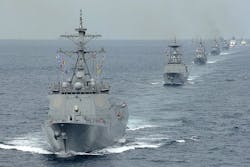Navy beefing-up air-defense capabilities of U.S., Japan, and South Korea surface warships
Officials of the Naval Sea Systems Command in Washington announced a $490.6 million contract modification Friday to the Lockheed Martin Mission Systems and Training segment in Moorestown, N.J., for Aegis Weapon System MK-7 ship sets for the navies of the Republic of Korea, Japan, and the U.S.
The Aegis Weapon System is a centralized, automated, command-and-control and weapons-control system for U.S. Navy Arleigh Burke-class destroyers and Ticonderoga-class cruisers, as well as for surface warships of five other of the world's navies.
The heart of the system is the AN/SPY-1 advanced automatic-detect and-track multi-function phased-array radar that handles search, track, and missile guidance simultaneously, with a track capacity of more than 100 targets.
Related: Navy looks to ATCA embedded computing architecture for Aegis upgrades
The Aegis Weapon System Mk 7 comprises nine elements: AN/SPY-1 radar; command and decision system; weapons control system; fire control system; GMLS Mk 26 or VLS Mk 41; Standard guided missile; Aegis display system; operational readiness test system; and Aegis combat training system. Link 16 and Cooperative Engagement Capability (CEC) also are part of the Aegis weapon system.
Aegis is capable of detecting, tracking, and shooting down long- and medium-range ballistic missiles, which could be beneficial in checking the growing ballistic missile capability of North Korea -- particularly in the Western Pacific.
The order to Lockheed Martin includes spare parts, engineering, testing, and installation on U.S. and allied surface warships. This order involves Aegis systems aboard Kongo- and Atago-class destroyers of the Japanese navy; Sejong the Great-class destroyers of the Republic of Korea navy; and Burke-class destroyers of the U.S. Navy. Spain, Norway, and Australia also operate the Aegis weapon system.
Aegis, also the name for the shield of the Greek god Zeus, has been aboard U.S. Navy surface warships since the 1980s. A computer-based command and decision interface is the core of the Aegis combat system, which enables the system to operate simultaneously against hostile aircraft and missiles, surface ships, and submarines.
story continues below
The Aegis weapon system is the primary component of the sea-based element of the U.S. Ballistic Missile Defense system. It is capable against subsonic and supersonic anti-ship cruise missiles and manned aircraft in all kinds of weather.
On this order Lockheed Martin will do the work in Moorestown, N.J.; Clearwater, Fla.; and Owego, N.Y., and should be finished by May 2022. For more information contact Lockheed Martin Mission Systems and Training online at www.lockheedmartin.com/us/mst.html, or Naval Sea Systems Command at www.navsea.navy.mil.
Learn more: search the Aerospace & Defense Buyer's Guide for companies, new products, press releases, and videos

